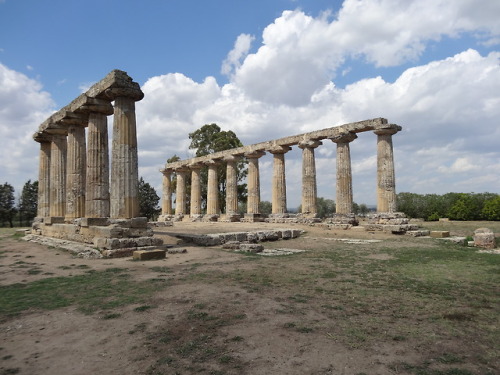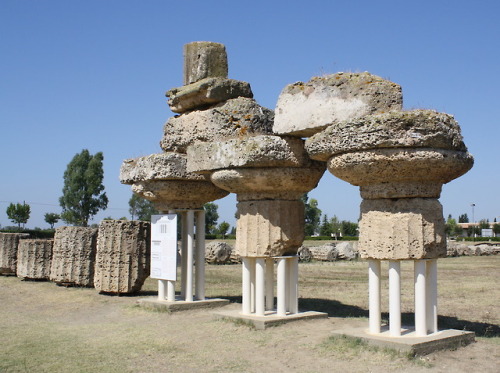


Tavole Palatine (“Palatine Tables”, Temple of Hera)
Metapontum *
6th century BCE
Doric order
The temple was composed of a central naos, preceded by a pronaos and with an adyton at the rear. Fifteen columns with twenty flutes and doric capitals survive. Of these fifteen columns, ten are on the north side and five on the southern side. Originally there were thirty-two columns, since the temple had a peristasis of twelve columns on each long side and six on each short side. The stylobate was 34.29 m (112.5 ft) long and 13.66 m (44.8 ft) wide, the naos 17.79 m × 8.68 m (58.4 ft × 28.5 ft). The temple has decayed significantly because it was built with local limestone (so-called mazzarro). In the fifth century BC, the temple had a tiled roof with multi-coloured decoration in the Ionic tradition, with leonine protomes and gargoyles.
Until the nineteenth century, the Tavole Palatine were also known locally as the Mensole Palatine (Palatine Shelves) or Colonne Palatine (Palatine Colonnade), probably in reference to the struggles of the French Paladins against the Saracens. The temple was also called the Scuola di Pitagora (School of Pythagoras) in memory of the great philosopher Pythagoras. In the Middle Ages it was also called the Mensae Imperatoris (Tables of the Emperor), probably referring to the Holy Roman Emperor Otto II who camped at Metapontum during his expedition against the Saracens in 982.
* One notable resident was the philosopher and mathematician Pythagoras (c. 571- c. 497 BCE) who spent the latter part of his life at Metapontum.




Комментариев нет:
Отправить комментарий